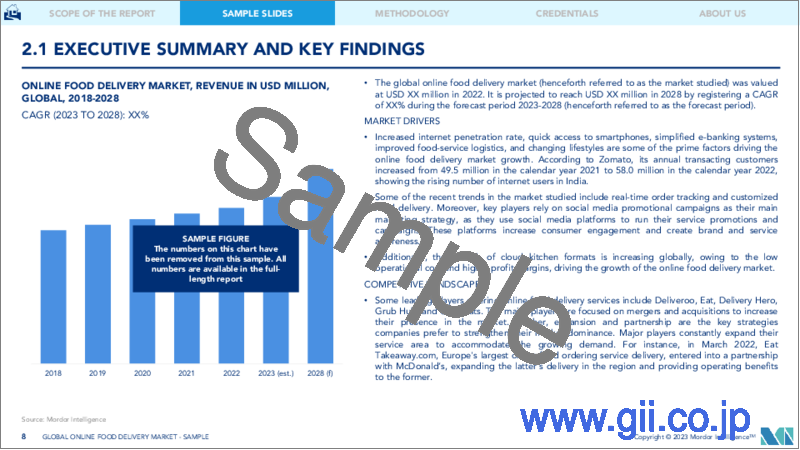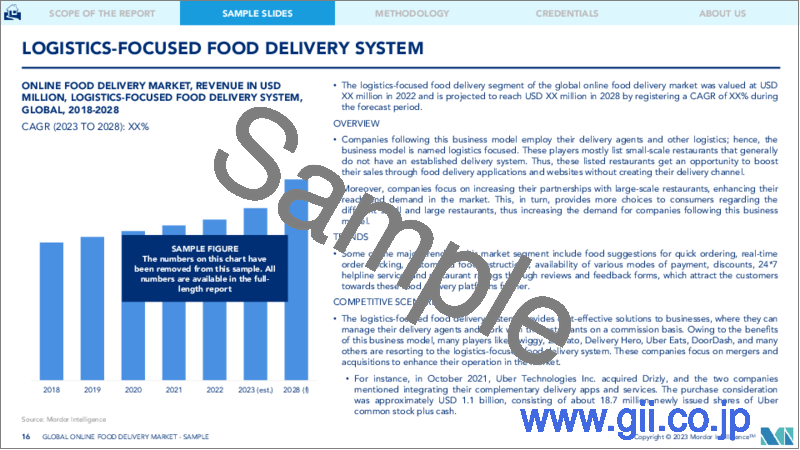|
|
市場調査レポート
商品コード
1197806
オンラインフードデリバリー市場- 成長、動向、予測(2023年~2028年)Online Food Delivery Market - Growth, Trends, and Forecasts (2023 - 2028) |
||||||
|
● お客様のご希望に応じて、既存データの加工や未掲載情報(例:国別セグメント)の追加などの対応が可能です。 詳細はお問い合わせください。 |
|||||||
| オンラインフードデリバリー市場- 成長、動向、予測(2023年~2028年) |
|
出版日: 2023年01月23日
発行: Mordor Intelligence
ページ情報: 英文 110 Pages
納期: 2~3営業日
|
- 全表示
- 概要
- 目次
オンラインフードデリバリー市場は、予測期間中(2023年~2028年)に16.24%のCAGRで推移すると予測されています。
COVID-19の大流行は、人々が商品にアクセスする能力を含め、生活のほとんどの面に大混乱をもたらしました。政府による封鎖のため、消費者は家に閉じこもり、通常の買い物ができなくなっています。多くのレストランが閉店したり、テイクアウトに頼らざるを得なくなったりして、生き残りをかけています。そんな中、COVID-19が抱える課題を解決してくれたのが、多くのお客さまにご利用いただいている宅配便です。コロナウイルスの大流行が世界を襲ったとき、食品産業と関連サービスは大きな衝撃を受けました。この大流行をきっかけに、インド政府はフードデリバリーやレストラン事業を重要サービスに分類することにしました。インドでは人口の20%以上が日常的にオンラインのフード&レストランサービスに依存しているため、顧客のオンライン化が急速に進んでいます。
顧客は急速にオンラインに向かい、それが過去10年間のeコマース業界の急成長を促しました。消費者の購買習慣の変化は、業界や国によって異なるものもあれば、世界の変化の産物であるものもあり、さまざまな原因によって促進されてきました。その多くは、オンラインフードデリバリー・ビジネスの増加、オンラインeコマースの発展に対する消費者の理解、サービスのオンライン決済がより簡単で安全になったこと、可処分所得の増加、在宅勤務により人々が自分で料理を作るために投資する時間が減少したことなどに起因していると思われます。
インターネット普及率の上昇、スマートフォンへの迅速なアクセス、電子バンキングシステムの簡素化、フードサービス物流の改善、ライフスタイルの変化などは、オンラインフードデリバリー市場の成長を促す主要因の一部となっています。例えば、インドのフードデリバリープラットフォームであるZomatoは、月間アクティブユーザー数が8000万人で、今後数年間で2000万人に到達する目標を掲げています。したがって、スマートフォンユーザーの増加とインターネットの普及が、オンラインフードデリバリーサービスの成長を促進しています。調査対象となった市場の最近の動向には、リアルタイムの注文追跡やカスタマイズされたフードデリバリーが含まれます。したがって、企業は研究開発(R&D)とマーケティングへの投資を増やし、市場での地位を維持するために地理的な範囲を拡大しています。大手企業の多くは、限られたコストとスピードの向上で規模の拡大を支援するモデルの能力により、ロジスティックに焦点を当てた食品配達システムを採用しています。
オンラインフードデリバリー市場の動向
クラウドキッチンの人気上昇
フードデリバリー市場では、多くの消費者がオンラインプラットフォームを通じて食品を購入するため、クラウドキッチンの人気が上昇しています。このように、利便性、消費者の多忙なライフスタイル、強力なインターネットの普及といった要因から、クラウドキッチンを通じた食品注文が増加しているのです。
クラウドキッチンは、既存のレストラン経営者と新規のレストラン経営者の両方にとって、フードビジネスを開くための人気のある投資先として浮上しています。Faasos by Rebel Foods、Biryani By Kilo、Freshmenuなどは、この分野で人気のあるクラウドキッチンチェーンです。老舗のレストランチェーンも、フードデリバリーの注文が多いため、ファミレスではなくクラウドキッチンの店舗を開くようになってきています。リーズナブルな価格で記録的な速さで料理を届けられるという手軽さから、オンラインでの注文が増加しているのです。外食の代わりに、注文することが好まれるようになったのです。オンラインフードデリバリーは、従来の外食レストランのシェアを奪っているだけでなく、家庭料理にも取って代わりつつあります。顧客の嗜好の変化と外食の面倒くささの増加により、宅配という選択肢が勢いを増し、それに伴い、今や食事が食事体験に勝るという外食産業の変化をもたらしているのです。例えば、食品注文・配達アプリのSwiggyは、Swiggy Accessと呼ばれる共有クラウドキッチンスペースを立ち上げ、新規および既存のレストランがこれらのキッチンスペースから配達のみのオペレーションを行うことを可能にしました。
北米が市場を席巻
北米市場は、主に米国における強力なユーザー普及率により、世界市場において高い市場シェアを誇っています。北米は、世界なオンラインフードデリバリーの最大市場の一つです。現在、世界最大のオンラインフードデリバリー市場を形成しています。北米のオンラインフードデリバリー市場は現在、いくつかの要因によって牽引されています。都市部の人口の多さ、彼らの多忙なライフスタイル、インターネットとスマートフォンの普及率の向上は、この地域のオンラインフードデリバリー市場の成長を牽引してきた重要な要因の一部です。さらに、消費者層の大半を占める米国の若年層人口の多さが、この成長をさらに促進しています。さまざまなオンラインフードデリバリーサービスプロバイダーが、自動運転車、ドローン、ロボットによる革新的なフードデリバリー方法を試みており、それによって市場の成長にプラスの影響を与えています。個人の高い生活水準は、この地域におけるオンラインフードデリバリー包装サービスの需要に拍車をかけ続けています。Doordash、Uber Eats、Postmates、GrubHub-Seamless、Caviarなどの北米の主要企業は、新製品開発、世界展開、買収、投資などのオンラインフードデリバリー市場の発展のための戦略を採っています。
オンラインフードデリバリー市場の競合他社分析
調査した市場は競争が激しく、オンラインフードデリバリーサービスを提供する大手企業には、Deliveroo、Just Eat、Delivery Hero、Grub Hub、Uber Eatsなどがあります。市場の優位性を強化するために企業が好む主要な戦略には、統合を達成し、提供物を最適化するための拡張、M&A、パートナーシップなどがあります。例えば、Swiggyはインドの既存の28都市に加え、新たに16都市でサービスを開始し、事業を拡大しました。プレイヤーは、技術革新、注文のカスタマイズ、提携レストラン数の増加などを提供し、サービスの向上に努めています。
その他の特典
- エクセル形式の市場予測(ME)シート
- アナリストによる3ヶ月間のサポート
目次
第1章 イントロダクション
- 調査の成果 と市場定義
- 調査対象範囲
第2章 調査手法
第3章 エグゼクティブサマリー
第4章 市場力学
- 市場促進要因
- 市場抑制要因
- ポーターのファイブフォース分析
- 新規参入業者の脅威
- 買い手/消費者の交渉力
- 供給企業の交渉力
- 代替品の脅威
- 競争企業間の敵対関係
第5章 市場セグメンテーション
- ビジネスモデル別
- 物流特化型フードデリバリーシステム
- オーダーメイド型フードデリバリーシステム
- 飲食店特化型フードデリバリーシステム
- プラットフォームタイプ別
- モバイル/タブレットアプリケーション
- Webサイト
- 地域別
- 北米
- 米国
- カナダ
- メキシコ
- その他北米地域
- 欧州
- スペイン
- 英国
- ドイツ
- フランス
- イタリア
- ロシア
- その他の欧州地域
- アジア太平洋地域
- 中国
- 日本
- インド
- オーストラリア
- その他アジア太平洋地域
- 南米
- ブラジル
- アルゼンチン
- その他の南米地域
- 中東地域
- アラブ首長国連邦
- 南アフリカ共和国
- その他の中東地域
- 北米
第6章 競合情勢
- 最も活発な企業
- 最も採用されている戦略
- 市場シェア分析
- 企業プロファイル
- Delivery Hero SE
- Grab Holdings Inc.
- Just Eat Holding Limited
- Grubhub Holding Inc.
- Uber Technologies Inc.
- Deliveroo
- Pizza Hut International LLC
- Delivery.com
- Domino's Pizza Inc.
- iFood
第7章 市場機会と今後の動向
第8章 COVID-19が市場に与える影響
The online food delivery market is projected to register a CAGR of 16.24% during the forecast period (2023 - 2028).
The COVID-19 pandemic has wreaked havoc on most facets of life, including people's ability to access products. Consumers have been held at home due to government-imposed lockdowns, preventing regular shopping habits. Many restaurants have closed or resorted to takeout in order to stay afloat. For many customers, home delivery has provided a solution to some of COVID-19's challenges. When the pandemic of coronavirus hit the world, the food industry and related services were heavily impacted. This outbreak led the Indian government to make the food delivery and restaurants business to be categorized as critical services. Since more than 20% of the population in India relies on online food and restaurants services on a daily basis.
Customers are rapidly heading online, which has fueled rapid growth in the e-commerce industry over the last decade. This shift in consumer shopping habits has been fueled by a variety of causes, some of which are industry or country-specific, while others are the product of global shifts. Most of it can be attributed to the availability of an increased number of online food delivery businesses, a better understanding by consumers of the developments of online e-commerce, a better easy and secure option for online payments of services, disposable income on the rise, work from home decreasing time for people to invest in making the food themselves.
Increased internet penetration rate, quick access to smartphones, simplified e-banking systems, improved food-service logistics, and changing lifestyles are some of the prime factors driving the online food delivery market growth. For instance, the Indian food delivery platform, Zomato, has 80 million monthly active users and has set targets of reaching 20 million over the next few years. Hence, an increase in smartphone users and internet penetration is driving growth in online food delivery services. Some of the recent trends in the market studied include real-time order tracking and customized food delivery. Thus, companies are increasing their investments in research and development (R&D) and marketing and expanding their geographical reach to maintain their position in the market. Most of the leading players are following logistics-focused food delivery systems due to the model's ability to help gain scale with limited costs and increased speed.
Online Food Delivery Market Trends
Rising Popularity of Cloud Kitchens
The food delivery market is witnessing a rise in the popularity of cloud kitchens due to many consumers purchasing their food through online platforms. Thus, the increasing number of food orders through cloud kitchens, due to the convenience factor, hectic lifestyles of consumers, and strong internet penetration.
Cloud kitchens have emerged as the popular investment choice for both established and new restaurateurs for opening a food business. Faasos by Rebel Foods, Biryani By Kilo, and Freshmenu are some of the popular cloud kitchen chains operating in this segment. Established restaurant chains are now also opening cloud kitchen outlets instead of opening a dine-in outlets to cater to high food delivery orders. The ease of getting food delivered at a reasonable price and in record time has led to an increase in the number of orders being placed online. Instead of dining out, people prefer to order in. Online food delivery is not only eating into the market share of traditional dine-in restaurants but is also replacing home-cooking. Because of the shift in customer preference and an increased sense of hassle in dining out, the home delivery option has gained momentum and, along with that, has brought a change in the restaurant industry as now food overpowers the dining experience. For instance, the food ordering and delivery app Swiggy launched shared cloud kitchen spaces called Swiggy Access and enabled new as well as existing restaurants to operate delivery-only operations from these kitchen spaces.
North America Dominates the Market
The North American market has a high market share in the global market, mainly due to strong user penetration rates in the United States. It is one of the largest markets for global online food delivery. It currently represents the world's biggest online food delivery market. North America's online food delivery market is currently being driven by several factors. Significant urban population, their busy lifestyles, and increasing penetration of the internet and smartphones are some of the key drivers that have driven the online food delivery market growth in the region. Moreover, the United States' large young population, which constitutes the majority of the consumer base, has further facilitated this growth. Various online food delivery service providers are experimenting with innovative food delivery methods via self-driving cars, drones, and robots, thereby positively influencing the market growth. The high living standards of individuals are continuing to spur the demand for online food delivery packaging services in the region. Some of the major players in North America, including Doordash, Uber Eats, Postmates, GrubHub -Seamless, and Caviar, are adopting strategies for the development of the online food delivery market like new products development, global expansion, acquisitions, and investments.
Online Food Delivery Market Competitor Analysis
The market studied is highly competitive, and some of the leading players offering online food delivery services include Deliveroo, Just Eat, Delivery Hero, Grub Hub, and Uber Eats. The key strategies preferred by companies to strengthen their market dominance include expansion, mergers and acquisitions, and partnerships to achieve consolidation and optimize their offerings. For instance, Swiggy expanded its operations by launching services in 16 new cities in addition to the existing 28 cities in India. Players are increasingly offering technological innovation, order customization, and increasing the number of partnering restaurants to improve their offerings.
Additional Benefits:
- The market estimate (ME) sheet in Excel format
- 3 months of analyst support
TABLE OF CONTENTS
1 INTRODUCTION
- 1.1 Study Deliverables and Market Definition
- 1.2 Scope of the Study
2 RESEARCH METHODOLOGY
3 EXECUTIVE SUMMARY
4 MARKET DYNAMICS
- 4.1 Market Drivers
- 4.2 Market Restraints
- 4.3 Porter's Five Forces Analysis
- 4.3.1 Threat of New Entrants
- 4.3.2 Bargaining Power of Buyers/Consumers
- 4.3.3 Bargaining Power of Suppliers
- 4.3.4 Threat of Substitute Products
- 4.3.5 Intensity of Competitive Rivalry
5 MARKET SEGMENTATION
- 5.1 By Business Model
- 5.1.1 Logistics-focused Food Delivery System
- 5.1.2 Order-focused Food Delivery System
- 5.1.3 Restaurant-specific Food Delivery System
- 5.2 By Platform Type
- 5.2.1 Mobile/Tablet Applications
- 5.2.2 Websites
- 5.3 Geography
- 5.3.1 North America
- 5.3.1.1 United States
- 5.3.1.2 Canada
- 5.3.1.3 Mexico
- 5.3.1.4 Rest of North America
- 5.3.2 Europe
- 5.3.2.1 Spain
- 5.3.2.2 United Kingdom
- 5.3.2.3 Germany
- 5.3.2.4 France
- 5.3.2.5 Italy
- 5.3.2.6 Russia
- 5.3.2.7 Rest of Europe
- 5.3.3 Asia-Pacific
- 5.3.3.1 China
- 5.3.3.2 Japan
- 5.3.3.3 India
- 5.3.3.4 Australia
- 5.3.3.5 Rest of Asia-Pacific
- 5.3.4 South America
- 5.3.4.1 Brazil
- 5.3.4.2 Argentina
- 5.3.4.3 Rest of South America
- 5.3.5 Middle-East
- 5.3.5.1 United Arab Emirates
- 5.3.5.2 South Africa
- 5.3.5.3 Rest of Middle-East
- 5.3.1 North America
6 COMPETITIVE LANDSCAPE
- 6.1 Most Active Companies
- 6.2 Most Adopted Strategies
- 6.3 Market Share Analysis
- 6.4 Company Profiles
- 6.4.1 Delivery Hero SE
- 6.4.2 Grab Holdings Inc.
- 6.4.3 Just Eat Holding Limited
- 6.4.4 Grubhub Holding Inc.
- 6.4.5 Uber Technologies Inc.
- 6.4.6 Deliveroo
- 6.4.7 Pizza Hut International LLC
- 6.4.8 Delivery.com
- 6.4.9 Domino's Pizza Inc.
- 6.4.10 iFood




